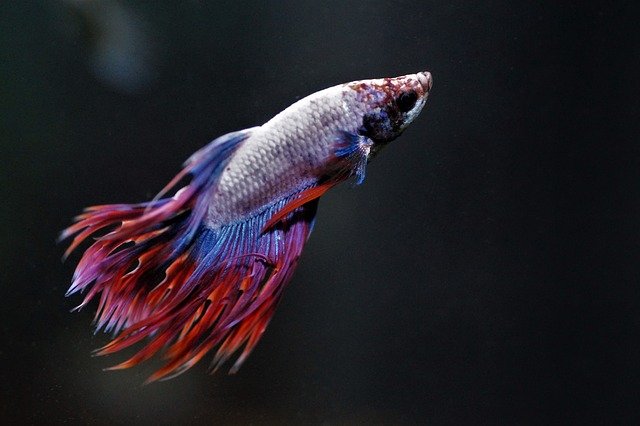Last Updated on June 9, 2021
Baby bettas or betta fry are delicate, and like all other babies, they need utmost care. Additionally, they have a weak immune system that makes them more prone to diseases.
It is vital to provide them a good living condition so they can grow into maturity. With the right environment and a proper supply of high-protein foods, your betta will thrive in no time.
In this article, we will discuss:
- How to take care of a newborn betta from eggs.
- Go about those bettas that you can buy in pet stores.
- How much space and what food you should feed your tiny betta.
Table of Contents
Baby betta care
As an owner, we all want to give our baby betta care and let them grow into a healthy, adult bettas. How do we do that? Here are some tips on how to care for your little friend:
Caring for newly-hatched baby bettas
Guarded by the male adult bettas, a newborn has yolk sacs in its bubble nest. While in these sacs, they won’t require food, but on their first 1 to 3 days, they will absorb it. By then, remove the male betta and start feeding your infant betta.
Male betta does not eat their own fry. But it will be easier to care for the babies once they leave the bubble nest and become free-swimming.
- 3 to 5 days
As they reach 3 to 5 days of age, you can feed them with microworms, vinegar eels, and/or infusoria. Do not feed them powdered dry foods as this will cause losing most of your babies.
Keep the water temperature at around 75 to 80 degrees Fahrenheit using a tank heater to raise their metabolism. Colder water will stress your newborn and could affect their growth or kill them.
As they grow, you can set up your brine shrimp hatchery. Their yolk sacs are beneficial for the baby bettas’ health. Rinse the brine shrimp in freshwater before feeding to the betta fry.
You can also feed them with live or frozen young daphnia and fairy shrimp. After four days, they are large enough to accept these foods.
- 8 to 14 days
Around 2 to 3 weeks, you can stop feeding them with eels, worms, and infusoria, as these are now small for them. If you want to increase their growth rate, food such as grindal worms and young white worms is your best bet. These are applicable as they reach 8 to 14 days of age.
However, as these have a high-fat content, do not feed it to the betta fry every day.
As much as live foods are great for them, those with high-fat content could lead to bloating and swim bladder disorder.
- 14 to 25 days
From 14 to 25 days, your baby bettas are now ready for dry food such as pellet. Get their attention by making the food fall and make it look like it’s moving. Clean their tank from any uneaten dry foods as these can disrupt the normal balance of water parameters caused by ammonia and nitrite spikes.
Maintenance and performing a water change are necessary every 2 to 3 days a week. Remember that your baby bettas are reactive to poor water quality. Clean the environment from any solid waste without harming your baby bettas.
However, be careful when handling them or removing them from the tank as they get stressed easily.
Caring for pet store baby bettas

Most fish stores sell baby bettas at around 28 to 42 days of age. Like newborns from eggs, they need to have similar adequate attention. Here’s how to take care of a baby betta fish from pet stores.
- Adequate space for growing
Transfer your baby bettas to tanks no smaller than one gallon. While baby bettas are small, they need adequate space to grow. Keeping them in tight containers or aquarium can stunt growth or put their well-being in danger.
It is also recommended for a baby betta to be kept alone in the tank to prevent stress. At 42 days, you can transfer them to a 10-gallon tank so they can continue to grow and be with other betta fish.
- Sponge filters for cleaning
Besides the frequent water changes, using a sponge filter also helps your baby fish. It creates a gently bubbling flow that is enough to filter the tank of a betta fry. It also features a control valve that allows you to adjust the flow which you can turn down anytime you need.
This is in comparison with other filters that can suck up the babies. These might also harm them because of the strong current.
- Live foods for feeding
For your baby bettas to thrive into maturity, a diet consisting of live foods are a way to go. As mentioned, live worms, daphnia, and brine shrimps are best for these babies until they get older.
You may also feed them with fry foods such as frozen and pellet foods. Baby bettas are likely to increase growth in frozen bay brine shrimp or frozen daphnia. You can thaw a block of these foods and feed it to your baby betta 2-3 times a day.
Food that is high in protein diet like Bug Bites can also help in accelerating the growth of your baby bettas. These types of food help reveal the tail type and coloration sooner.
At this rate, you can now separate the baby betta fish into individual cups. Female bettas have smaller tails and fins while males have longer fins and brighter colors.
Related: Best Food for Betta Fish to Keep it Full and Well
Conclusion
Taking care of a baby betta fish from eggs is crucial, as they require special attention. However, while they are older, baby bettas sold at pet stores also need extra caution.
At the end of the day, we want them to grow in the healthiest possible way.
